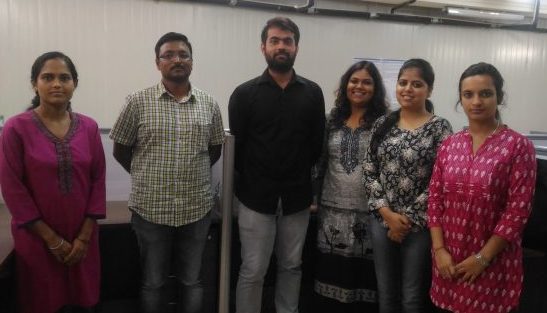Research summary
Computational structural and systems biology
The main research interest of our group is to understand the role of promiscuous enzymes in the evolution of metabolic pathways and in the robustness of metabolic networks.
Microorganisms have the diverse metabolic capability and show remarkable resilience towards genetic and environmental perturbations. This metabolic robustness is usually attributed to the alternate pathways in metabolic network that maintain the constant fluxes of essential metabolites. However, recent studies suggest promiscuous activities of enzymes can also play a significant role in alternate metabolic routes. The promiscuous activities of enzyme refer to their adventitious secondary less efficient catalytic activities of enzymes for which they are not physiologically specialized or evolved. This promiscuity can become important under certain genetic/ environmental perturbations. Hence, to study the effect of enzyme promiscuity on metabolic network we are reconstructing metabolic networks including promiscuous reactions. Due to lack of enzyme promiscuity experimental data, recently we used chemoinformatics approach with reaction molecular signatures to generate all possible reactions for all enzymes encoded in genomes with an assumption that enzymes will accommodate all possible compounds. We plan to systematically investigate this assumption by analysis of structural and sequence properties of enzymes or substrates binding sites, which confers them promiscuity. In this process, we have developed meta- predictor catalytic residues prediction method (CSmetaPred) to better characterize enzymes. We are also involved in understanding the structural and sequence basis of enzyme promiscuity. For enzyme function classification, we have developed motif-based methods to classify enzymes into subfamilies. We also use Molecular dynamics approach to unveil the molecular basis of enzyme functions.
Many enzymes are multi-domain proteins and experimental tertiary structures are not yet known for most multi-domain enzymes. For tertiary structure prediction of multi-domain enzymes, we are developing robust structure prediction method employing recently developed structure prediction method TASSER (Threading ASSembly and Refinement).
Selected Publications
- P Choudhary, S Kumar , A. K. Bachhawat, S. B. Pandit CSmetaPred: a consensus method for prediction of catalytic residues. BMC Bioinformatics. 2017 Dec 22;18(1):583.
- Carbonell P, Fichera D, Pandit S. B., Faulon JL. (2012) Enumerating metabolic pathways for the production of heterologous target chemicals in chassis organisms. BMC Syst Biol. 6:10 (Highly accessed).
- S. B. Pandit and J. Skolnick (2010) TASSER_low-zsc: An approach to improve structure prediction using low z-score ranked templates Proteins 78(13):2769-2780.
- S. B. Pandit, Brylinski, M, Gao M, Arakaki, A and J. Skolnick (2010) PSiFR: An integrated resource for prediction of protein structure and function. Bioinformatics, 26(5): 687-688.
- S. B. Pandit and J. Skolnick (2008) Fr-TM-align : A new protein structural alignment method based on fragment alignments and the TM-score. BMC Bioinformatics 9:531 (Highly accessed).
- H. Zhou, S. B. Pandit, S. Lee, J. Borreguerro, H. Chen, L. Wroblewska and J. Skolnick (2007). Analysis of TASSER based CASP7 protein structure prediction results. Proteins 69(S8): 90-97.
- S. B. Pandit, Y. Zhang and J. Skolnick. (2006) TASSER-Lite: An automated tool for protein comparative modeling. Biophysical Journal 91: 4180-4190.
- O., Krishnadev, N. Rekha, , S. B. Pandit, S. Abhiman, S. Mohanty, L. Swapna, S., Gore, and N. Srinivasan, (2005) PRODOC: a resource for the comparison of tethered protein domain architectures with in-built information on remotely related domain families. Nucleic Acids Res., 33 (Web Server issue):W126-129.
- S. B. Pandit and N. Srinivasan. (2003) Survey for G-proteins in the prokaryotic genomes: prediction of functional roles based on classification. Proteins: Structure function and genetics 52, 585-597. (Recommend article in Faculty of 1000 Biology).
- S. Gupta, S. B. Pandit, N. Srinivasan and D. Chatterji (2002) Proteomics analysis of carbon starved Mycobacterium smegmatis: Induction of Dps like protein. Prot. Eng. 15, 503-511.
- S. B. Pandit, D. Gosar, S. Abhiman, S. Sujatha, S.S. Dixit, N.S. Mhatre, R. Sowdhamini and N. Srinivasan (2002) SUPFAM – Database of potential protein superfamily relationships derived by comparing sequence-based and structure-based families: Implications for structural genomics and function annotation in genomes. Nucl. Acids Res. 30, 289-293.
Group
Present group members
- Preeti Choudhary (PhD student)
- Rivi Verma (PhD student)
- Deeksha Thakur (PhD student)
- Paras Varma (PhD student)
- Mridul (BS-MS student)
Alumni:
- Keetika Garg (BS-MS)
- Swapnil Tickule


